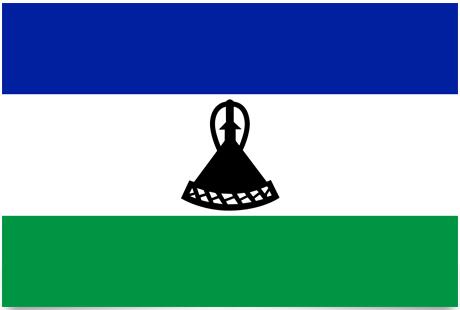Lesotho Flag and Meaning
Flag of Lesotho

Lesotho Flag Meaning
The flag was adopted on October 4, 2006, in connection with the celebration as an independent state for 40 years. The white color stands for peace, the green stands for the prosperity of the country and the blue is a symbol of what they call pula, the rain, which is crucial for all forms of life in their arid climate. In the middle of the flag you see the image of a traditional headdress, markorotlo, from the Basotho people. This headdress, which is made of straw, has been part of the national costume since the early 20th century, but was spread during the Second World War. In the 1950s, political leaders used the hat as a marker of belonging to traditional tribal and village hierarchies.
Lesotho Overview
| Population | 2 million |
| Currency | Malotis |
| Area | 30.355 km² |
| Capital city | Maseru |
| Population density | 65.8 residents/km² |
| HDI location | 141 |
This small country lies in the suburbs of the Drakensberg Mountains in South Africa. The land is without coasts, mountainous and only in the western part of the country has lands suitable for agricultural production (maize and wheat). The rest of the country is used for sheep breeding. Apart from small deposits of diamonds, the country does not have mineral resources. The most serious environmental problem is soil erosion. The shortage of water will be further exacerbated when a projected hydroelectric power plant in the Highlands begins redirecting water resources to South Africa.
The people: The country is predominantly (85%) inhabited by the Basotho or Sotho people who have Bantu origin. The Zulus make up 15% of the population, and there is also a small Asian and European minority.
Religion: Predominantly Christian (93%), of which 42.8% are Catholics, 29.1% Protestants and 21.1% belong to other Christian faiths. Furthermore, 7% of the population practices traditional African religions.
Languages: Sesotho and English (official)
Political parties: The Lesotho Congress for Democracy (formerly the Basotho Congress Party) is the government party. Basothos National Party founded in 1958. Lesothos Communist Party founded in 1962. Marematlou Liberation Party founded in 1962. National Independence Party founded in 1984. Basothos Democratic Party founded in 1984. Democratic People’s Front, a scaling off of the Communist Party. The Basothos Kopanang Party founded in 1992 was at the forefront of women’s rights campaigns. The National Progress Party founded in 1995, peeling off the Basotho National Party. The Christian Democratic Party was founded in 1998, a scaling off of the National Progress Party.
Social organizations: Lesotho General Workers Union (LGWU), founded in 1954, is the country’s only national organization.
Official name: Kingdom of Lesotho.
Administrative subdivision: 10 districts
Capital: Maseru, 227,000 in (2006).
Other important cities: Maputsoe; 32,800 inb, Mafeten 29,400 inb (2000).
Government: Parliamentary Monarchy. King Letsie III has been the country’s head of state since November 1990 (except for a period in 1995-96). Tom Thabane has been Prime Minister since June 2017. Two Chamber Parliament: The National Assembly with 120 seats and the Senate with 33.
National Day: October 4 (Independence Day, 1966)
Armed Forces: 2,000 Soldiers (1996).













































